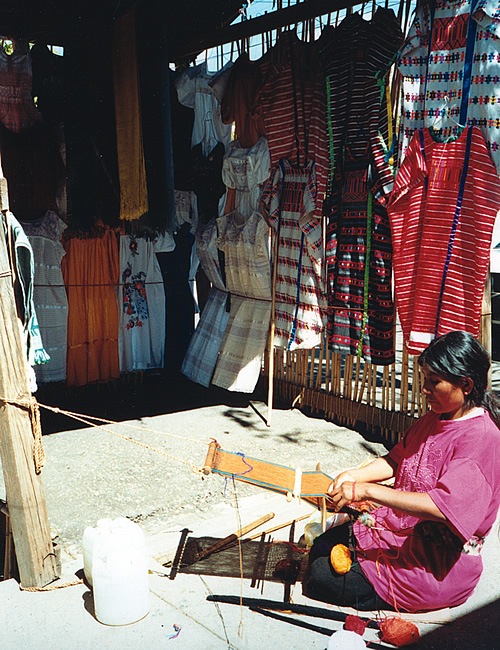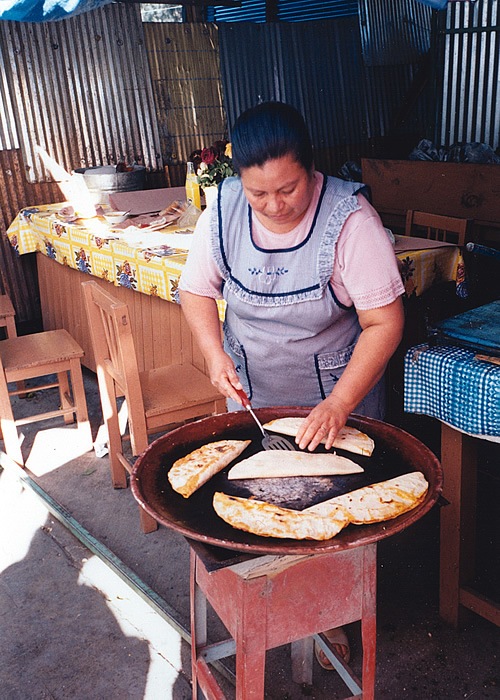Spanish in Oaxaca, Mexico Through the Senses
Language School "Extras" Can Be the Main Course
Article and photos by Linda McDonnell

When I went to Oaxaca, Mexico to learn Spanish I never imagined that some of my best lessons would be in the kitchen.
Like many language immersion schools, the one I’d chosen offered cooking as part of a menu of optional cultural activities. Cooking had a special appeal since Oaxaca is renowned for its rich cuisine with deep
pre-Hispanic roots.
Laura, the instructor, began with an introduction to the day’s recipe — all in Spanish. Listening, watching, doing, and concentrating mightily, I learned to make pollo en barbacoa, chicken in Mexican barbecue
sauce. “Dos dientes de ajo,” said Laura, picking up two cloves of garlic. I recognized comino (cumin) and orégano by their aroma. As Laura held up the chilies, I learned that guajillo is a favorite Mexican variety.
I learned to identify the flavors of Oaxacan food with the musical sound of their ingredients. Canela, pimienta negra, cebolla: they rolled off Laura’s tongue and heightened the allure of the flavors that I’d
always known simply as cinnamon, black pepper, and onion.
“Todos los ingredientes molidos,” said Laura, setting the blender awhirl — "molidos," that most useful word in Oaxacan cooking, meaning “ground.”
As I relaxed over the meal I’d just cooked in my new language, I was glad I hadn’t dismissed this opportunity as a mere “fun” class and separated it from the real business of learning.
No Better Way to Learn
There is no better way to learn Spanish and local culture than through participation in such activities as learning to cook the local foods. Even back home, as my blender whirls tomatoes and herbs into a summer salsa,
I hear myself repeating “todos los ingredientes molidos.”
Excursions offer the same opportunity. In the markets, where all the senses are re-tuned to this new world of colors, sights, and aromas, it becomes perfectly natural to see pollo, queso, and tomates instead of chicken,
cheese, and tomatoes. In the craft classes, the colors of textiles and ceramics take on a new vibrancy in the local tongue.
The immersion schools tie the learning all together. In the structured classes, you expand your proficiency with grammar and sentence structure and gain fluency in conversation. In the enrichment activities, you put
that learning to work and make it stick with the vocabulary of the sights and sensations around you. If your passion is crafts, music, or history, you can fall in love with it all over again in Spanish.
Oaxaca abounds with just such opportunities. The school I attended, Becari, offers programs from
the basic three hours of structured classes per day to six hours that include afternoon workshops in cooking, crafts, folk dancing, and more. Optional activities include cultural events and excursions to nearby archeological sites and
village markets. You can also sign up for an intercambio, which pairs you with a Mexican student learning English for conversation exchanges. The school will arrange accommodations, including homestays.

|
For More Info on Oaxaca
Situated in a valley in southern Mexico, Oaxaca is known for its colonial architecture, its nearby archeological sites, and its many different ethnic groups with their distinctive crafts, foods,
and festivals. The city is easy to reach by plane or bus. Mexicana/Aeromexico offers five direct flights daily from Mexico City. The 55-minute flight costs about $250 roundtrip, depending on travel schedule. Inexpensive first- and second-class
buses leave six times a day for the 6- to 7-hour trip traversing magnificent landscapes through the Mexican sierras.
Becari is located in a 200-year-old building with a sunny courtyard for socializing. Classes are small, with a maximum of five students. Students can enroll any Monday and stay for a week
to several months. The 6-hour daily program with morning language classes and afternoon workshops in various combinations of weaving, ceramics, cooking, or salsa and folkloric dance costs $320 per week, plus a one-time $70 registration
fee. A basic program of three hours daily of language classes costs $150.
Individual language lessons cost $17 per hour. Fieldtrips can be arranged to archeological sites and village markets for very modest fees.
For students seeking school-arranged accommodations, there are several options. A private room in a homestay with breakfast costs $140 per week; with half board the cost is $175; with full board it’s
$195. Free airport pickup is included with homestays. Mid-level hotel rooms begin at about $25-40 per night; small apartments with kitchens start at about $400-$700 per month. Becari’s language school site includes complete information on the school’s programs and online registration.
To find more cultural immersion programs, see our section on Language Schools in Mexico.
|
Linda McDonnell is a freelance writer and EFL teacher in Portland, OR.
|
